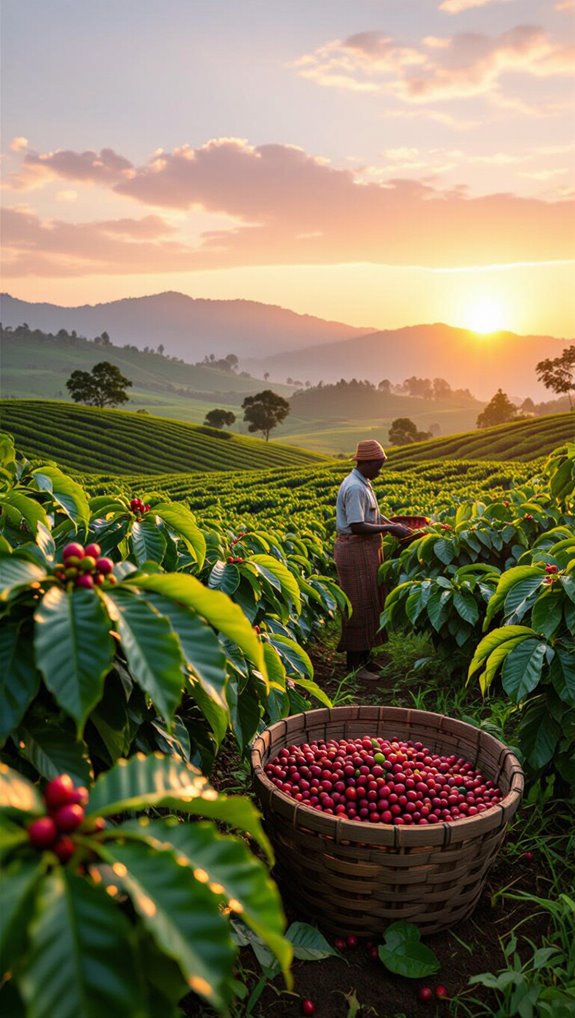Ever wondered why specialty coffee enthusiasts get so excited about Burundi coffee? Most people have never even heard of this East African origin, yet it consistently produces some of the most vibrant and complex beans in the world.
Burundi coffee offers something truly special: bright citrus notes, sweet red berry flavors, and a silky body that stands out from your typical morning cup. These beans are grown by smallholder farmers on volcanic slopes at high altitudes, creating ideal conditions for exceptional quality. In this guide, you’ll discover everything about Burundi’s coffee origins, what makes its flavor profile so distinctive, and which roasts bring out the best in these remarkable beans.
Whether you’re new to specialty coffee or looking to expand your palate, understanding Burundi coffee will open up a whole new world of flavor possibilities for your daily brew.
Table of Contents
What Makes Burundi Coffee So Special Today
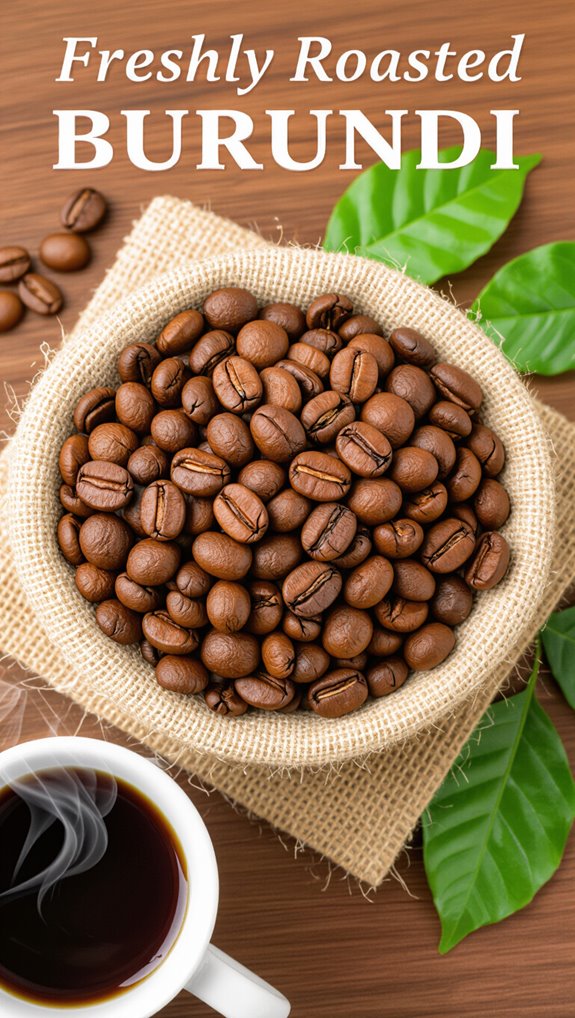
While many coffee origins boast impressive qualities, Burundi stands out as a hidden gem in the specialty coffee world, offering a truly exceptional drinking experience that’ll captivate even the most discerning coffee enthusiasts.
Its high-altitude volcanic landscapes create a perfect environment for growing complex Arabica beans with extraordinary flavor profiles. The unique terroir delivers coffees bursting with bright citrus acidity, vibrant fruit notes, and delicate floral aromatics. Coffee sector sustainability efforts by local farmers further enhance the region’s commitment to producing world-class beans.
Meticulous processing techniques like double washing and precise fermentation ensure each bean showcases remarkable clarity and nuanced sweetness that sets Burundi coffees apart from other origins.
Where Does Burundi Coffee Come From Exactly
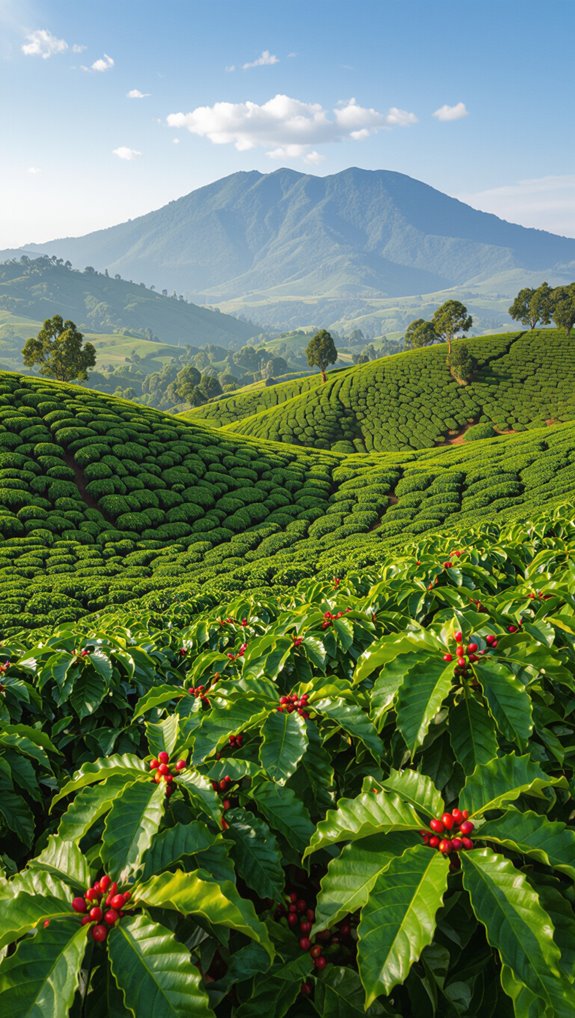
Nestled in the heart of East Africa, Burundi’s coffee emerges from a breathtaking landscape of rolling hills, volcanic soils, and high-altitude regions that create a perfect ecosystem for exceptional coffee production. The country’s coffee primarily grows in northwestern and northern regions like Muyinga, Bubanza, and Buyenzi, spanning elevations between 1,200 and 2,000 meters above sea level. Belgian colonists introduced Arabica coffee to the region in the 1920s, establishing the foundation for what would become a significant agricultural export.
| Region | Elevation | Key Characteristics |
|---|---|---|
| Muyinga | 1,800m | Bordering Tanzania |
| Kayanza | 2,000m | High acidity, bright notes |
| Bweru | 1,500m | Rich volcanic soil |
These diverse microclimates contribute to Burundi’s distinctive Arabica beans, particularly the beloved Bourbon cultivar, producing coffees with complex flavor profiles that capture the essence of this remarkable African coffee-growing nation.
The Unique Flavor Profile of Burundi Beans
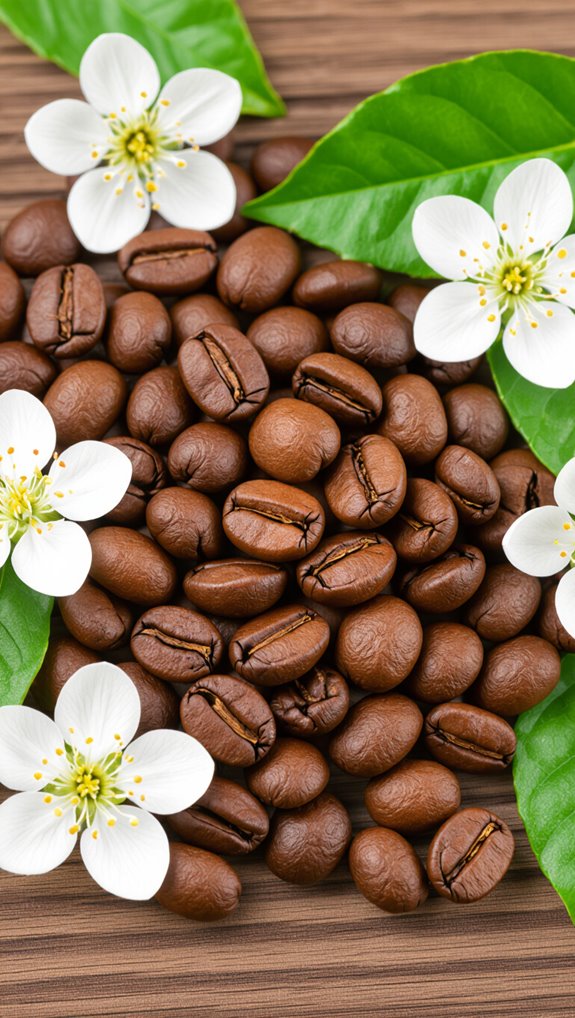
When you first sip a Burundian coffee, you’ll immediately discover a flavor profile that’s nothing short of extraordinary—bright, complex, and utterly captivating.
Red Bourbon varietals deliver vibrant citrus acidity with orange, lemon, and grapefruit notes dancing alongside juicy red berries and tropical stone fruits.
The coffee’s signature profile boasts delicate floral aromatics like jasmine and orange blossom, complemented by sweet undertones of caramel and honey.
Washed processing methods ensure a clean, crisp mouthfeel that highlights the beans’ inherent complexity, making each cup a sensory journey through Burundi’s high-altitude landscapes.
The unique terroir of volcanic soil regions contributes to the exceptional depth and nuanced flavor characteristics found in Burundian coffee beans.
How Coffee Growing Changed Life in Burundi
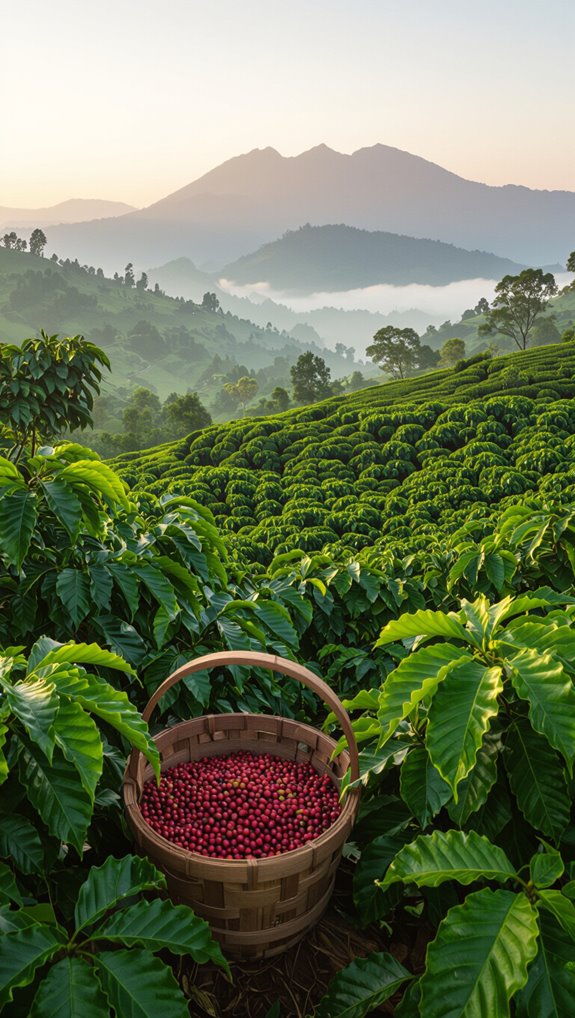
The journey from vibrant red coffee cherries to a transformative economic lifeline reveals how coffee cultivation reshaped Burundi’s social and economic landscape.
For over 600,000 families, coffee became more than a crop—it’s a pathway out of poverty, generating crucial income and creating jobs across processing and export sectors.
Generational coffee farming traditions have turned family plots into economic survival strategies.
Best Ways to Brew Your Burundi Coffee

To brew the perfect cup of Burundi coffee, you’ll want to focus on your brewing equipment and precise instructions that highlight its unique flavor profile.
I’ll walk you through the essential tools and techniques that’ll transform your home brewing experience, from selecting the right grinder to mastering water temperature.
Each method—whether pour-over, Aeropress, or French Press—offers a different way to unlock the vibrant fruit notes and complex sweetness characteristic of these exceptional beans.
Equipment
Because Burundi’s coffee demands precision and passion, selecting the right brewing equipment can transform your cup from ordinary to extraordinary.
Drip brewers like the Kalita Wave excel at balancing Burundian coffee’s acidity, while pour-over methods highlight delicate flavor nuances.
For those seeking body and sweetness, a French Press works wonders with medium roasts.
AeroPress remains a favorite for its ability to extract rich, smooth profiles.
Traditional Burundi Bush Brew offers an authentic experience for adventurous coffee lovers, using simple tools like a mortar and pestle to create a unique brewing ritual.
Instructions
Brewing Burundi coffee transforms your morning ritual from mundane to magical, unlocking a symphony of vibrant flavors waiting to dance across your palate.
Start with filtered water heated to 94-98°C, ensuring optimal extraction. For pour-over methods, begin with a 45-60g bloom, gently swirling to saturate grounds and release gases. Use circular pouring motions, adding water in stages to maintain even extraction.
Aim for a 1:15 coffee-to-water ratio and a total brew time of 2:45 to 3:00 minutes.
Kayanza and Ngozi: The Top Growing Regions
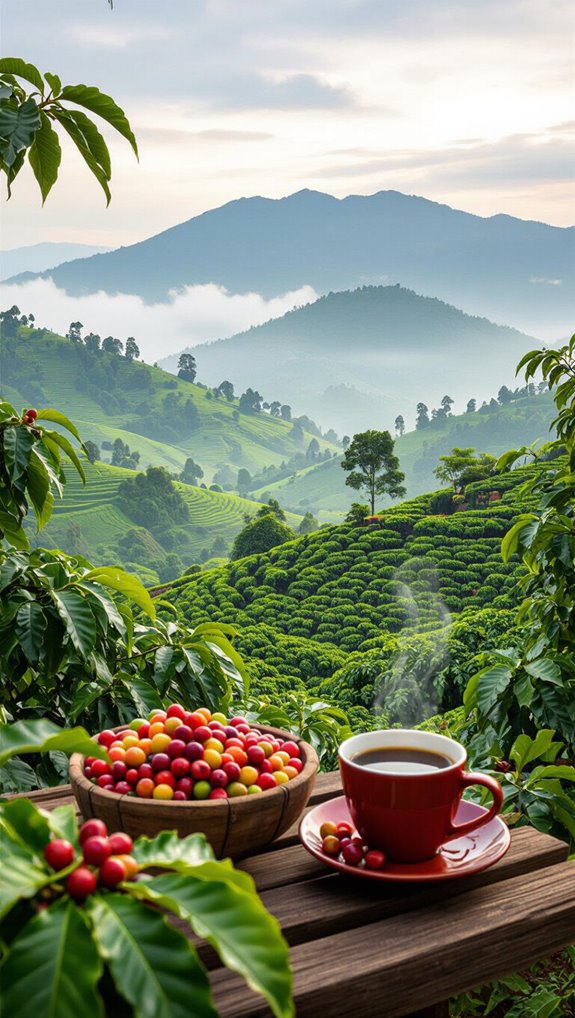
Burundi’s coffee-growing landscape shines brightest in the highland regions of Kayanza and Ngozi, where small-scale farmers cultivate exceptional specialty coffee at elevations between 1,700 and 2,000 meters above sea level. These regions boast volcanic soils and cool climates that produce incredibly vibrant coffees with remarkable flavor profiles.
Most farmers here manage tiny plots—around 0.1 hectares with roughly 250 coffee trees—while also growing subsistence crops like bananas and beans. Washing stations play a critical role, enabling these smallholders to process high-quality cherries and access specialty markets through collective processing.
The result? Extraordinary coffees bursting with citrus, red fruit, and complex tropical notes.
Light Roast vs Dark Roast Burundi Coffee

How do the roast levels transform Burundi’s extraordinary coffee from bright and fruity to rich and chocolatey?
Light roasts preserve the coffee’s vibrant character, showcasing red berries, jasmine, and tangy citrus notes.
As roasting intensifies, these delicate flavors give way to deeper chocolate and smoky undertones.
Dark roasts develop a fuller body, reducing acidity and highlighting cocoa complexity.
Your brewing choice depends on preference: seek a crisp, wine-like experience with light roasts or indulge in a velvety, bittersweet profile with dark roasts.
Each level unveils a unique dimension of Burundi’s exceptional coffee landscape.
Why Burundi Coffee Is Called Hidden Champion
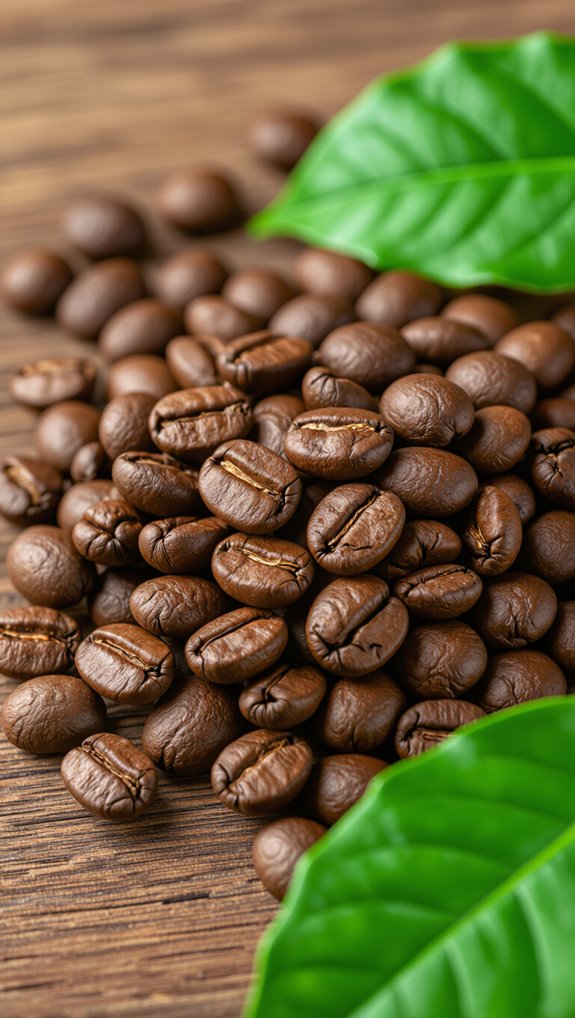
Although often overlooked in the global coffee landscape, Burundi has emerged as a hidden champion of specialty coffee, transforming from a war-torn region with a troubled agricultural history to a source of extraordinarily complex and vibrant beans.
The country’s coffee renaissance stems from its remarkable terroir: high-altitude volcanic regions, nutrient-rich soils, and ideal climate conditions that produce exceptionally sweet, juicy coffees with remarkable red berry and citrus notes.
With over 600,000 families involved in cultivation, Burundi’s coffee represents more than a beverage—it’s a testament to resilience, community revival, and extraordinary potential.
How to Buy Quality Burundi Coffee Beans

Navigate the world of Burundi coffee with confidence by mastering key selection criteria that separate exceptional beans from ordinary offerings. Focus on high-altitude, Bourbon varietal beans from renowned regions like Kayanza, prioritizing fully washed processing and current-season harvests.
Look for beans showcasing vibrant citrus acidity, sweet red berry notes, and complex sugar-browning flavors. Opt for medium roasts that highlight delicate floral and fruit characteristics, ensuring optimal flavor expression.
Choose suppliers committed to direct trade, sustainable practices, and transparent sourcing to support ethical coffee production while guaranteeing premium quality.
Burundi Coffee Compared to Rwandan and Ethiopian

After exploring the nuanced art of selecting premium Burundi coffee beans, let’s broaden our perspective by comparing its distinctive characteristics with neighboring Rwanda and legendary Ethiopian coffees.
Burundi’s coffee distinctiveness emerges through comparisons with regional powerhouses:
- Flavor profiles range from sweet berry and floral notes to rich, creamy bodies, subtly different from Rwanda’s bright citrus and Ethiopia’s wild, complex tastes
- Growing conditions share high-altitude volcanic terrains, with Burundi and Rwanda closely mirroring each other’s agricultural landscapes
- Processing methods predominantly involve wet processing, though Ethiopia introduces more diverse traditional techniques like dry processing
These nuanced differences highlight the unique terroir and cultural approaches defining each region’s coffee identity.
Frequently Asked Questions
Is Burundi Coffee Organic and Sustainably Sourced?
Yes, Burundi’s coffee is increasingly organic and sustainably sourced. I’ve seen how local cooperatives are transforming their practices, working with international partners to implement organic standards and sustainable land management techniques.
How Much Caffeine Is in a Typical Burundi Coffee?
I’ve found that a typical 8 oz cup of Burundi coffee contains around 80-115 mg of caffeine. Since it’s predominantly Arabica, the levels are moderate, varying slightly with roast and brewing method.
Can Burundi Coffee Be Used for Espresso or Cold Brew?
Yes, Burundi coffee is fantastic for espresso and cold brew! I’ve found its bright, fruity profile shines in both methods. Light to medium roasts work best, delivering sweet chocolate and berry notes that’ll make your taste buds dance.
What Are the Average Prices for Burundi Coffee Beans?
I’ll tell you straight: Burundi coffee beans typically range from $3.36 to $7.85 per pound wholesale, and $10.58 to $17.31 per kilogram retail. Roaster prices can hit up to $23.50 per pound for premium single-origin beans.
Are There Any Health Benefits Unique to Burundi Coffee?
Based on research, I can’t definitively claim unique health benefits. Burundian coffee shows promising antioxidant and potential metabolic properties in lab studies, but more human research is needed to confirm its distinctive health advantages over other coffee origins.
In Conclusion
If you’re looking for a truly exceptional coffee experience, Burundi beans are your ticket to flavor paradise. These volcanic slope treasures offer a complex symphony of citrus, red berries, and jasmine that’ll transform your morning routine. By choosing Burundi coffee, you’re not just enjoying an incredible brew—you’re supporting smallholder farmers and experiencing a remarkable terroir that represents the best of specialty coffee.
Ready to unlock the full potential of Burundi coffee at home? The right brewing equipment makes all the difference in capturing those delicate floral notes and bright acidity that make these beans so special. Check out our coffee machine reviews to find options that’ll help you extract every nuanced flavor from these remarkable African beans.
Whether you’re new to Burundi coffee or already a devoted fan, investing in quality beans from this East African gem is a decision your palate won’t regret. Start your journey with these extraordinary coffees and discover why specialty coffee enthusiasts consider Burundi one of the world’s most exciting coffee origins.

